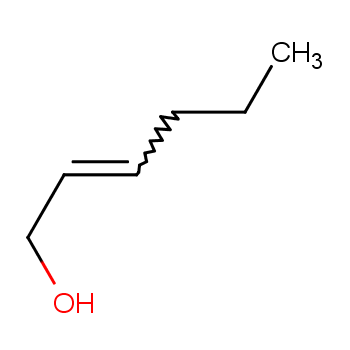 |
trans-2-Hexen-1-ol, referred to as 2-hexenol, is a fresh A component of the raspberry aroma, this substance has been detected in Valencian orange juice and apples and is found in nature in most cases as esters. Commonly used to prepare apples, strawberries, oranges, vegetables, tea, kiwis, tomatoes, bananas, mint, pears, berries and other food flavors. The concentration of trans-2-Hexen-1-ol in the final flavored food is approximately 0.63~4.1 mg/kg[1-2].

Figure 1 trans-2-Hexen-1- The structural formula of ol.
< /p>
Figure 2 Synthetic route of trans-2-Hexen-1-ol [3].
Integrate (Z)-2-hexen-1-ol (174) and n-butyllithium (2.5 M hexane, 0.5 mL, 1.25 mmol ) was added dropwise to a cooled (0 °C) solution of alcohol (174) (0.145 mL, 1.22 mmol) in THF (8 mL). The alkoxide was degassed twice before adding the catalyst via cannula: (a) [Rh(dppe)COD]ClO4 (44.5 mg, 0.063 mmol) in THF (12 mL). In this case, the reaction was refluxed for 5 minutes and then quenched with saturated aqueous ammonium chloride solution (10 mL). Separate the layers and extract the aqueous phase with diethyl ether (2 x 10 mL). The combined organic phases were washed with brine (10 ml), dried (MgSO4) and evaporated. NMR analysis was performed on each crude reaction mixture. The synthesized compound was finally determined to be trans-2-Hexen-1-ol. The synthesis route is shown in Figure 2.
![Figure 3 of trans-2-Hexen-1-ol Synthetic route[4]. Figure 3 Synthetic route of trans-2-Hexen-1-ol[4].](https://imgen3.guidechem.com/img/answer/2023/10/18/1697639337484120.jpg)
Figure 3 Synthetic route of trans-2-Hexen-1-ol [4].
Analysis of biotransformation and product formation Cultures of yeast strains containing LOX and HPL expression plasmids in baffled shake flasks with appropriate SCD dropout medium Grow to an OD600nm of 1.0 and use directly for biotransformation or harvest by centrifugation. After resuspension in this buffer (OD600nm of 1.0), transfer 15 ml to a 100 ml baffled shake flask. Begin biotransformation using growing or resting cells by adding 58 µl of substrate solution (50 µl ethanol mixed with 8 µl 70% pure linolenic acid). The flask was incubated at 25°C on an orbital shaker (180 rpm). To perform a qualitative analysis of the volatiles formed during bioconversion, we exposed 75 μm CarboxenTM PDMS solid-phase microextraction (SPME) fibers (Supelco, Bellefonte, PA, USA) to the flask headspace 10 min after 60 min bioconversion. . Analysis was performed by GC-FID (GC 17A, Shimadzu, Kyoto, Japan). The compound of interest was identified as trans-2-Hexen-1-ol. The synthesis route is shown in Figure 3.
![Figure 4 of trans-2-Hexen-1-ol Synthetic route[5]. Figure 4 Synthetic route of trans-2-Hexen-1-ol[5].](https://imgen3.guidechem.com/img/answer/2023/10/18/1697639339139732.jpg)
Figure 4 Synthetic route of trans-2-Hexen-1-ol [5].
To a stirred solution of dichloride 5a (17 mg, 0.04 mmol) in HMPA (0.7 mL) at room temperature was added NaI (154 mg, 1.03 mmol) and the mixture was heated at 160 °C for 2 h. After adding saturated Na2S2O3, the mixture was poured into a separatory funnel and extracted with Et2O. The organic phase was separated, dried over MgSO4, filtered and concentrated. The residue was purified by flash silica gel column chromatography (EtOAc/hexane 1:6) to give the intermediate as a colorless oil. Deacetylation with TBAF was then continued: To a solution of the (E)-olefin (67 mg, 0.20 mmol) obtained above in THF (1.7 mL) at room temperature was added TBAF (1.0 M in THF, 0.26 mL, 0.26 mmol ) and stir the mixture for 45 minutes. After adding saturated NH4Cl, the mixture was poured into a separatory funnel and extracted with EtOAc. The organic phase was separated, dried over MgSO4, filtered and concentrated. The residue was purified by flash silica gel column chromatography (EtOAc/Hexane 1:4) to obtain trans-2-Hexen-1-ol as a colorless oil, yield 10.5 mg, 53%. IR (pure) ν3354, 2959, 1456, 968 cm-1; 1H NMR (300 MHz, CDCl3) δ: 5.75-5.58 (m, 2H), 4.09 (d, 2H, J=4.7 Hz), 2.06-1.99 ( m, 2H), 1.53 (brs, 1H), 1.48-1.32 (m, 3H), 0.91 (t, 3H, J=7.3 Hz); 13C NMR (75 MHz, CDCl3) δ: 133.3, 129.0, 63.8, 34.3 ,22.2,13.6. The synthesis route is shown in Figure 4.
Based on currently available data and usage levels, trans-2- There are no genotoxicity issues with Hexen-1-ol. trans-2-Hexen-1-ol was evaluated in a BlueScreen assay and found to be genotoxicity negative in the presence of S9 metabolic activation and positive in the absence of S9 metabolic activation, indicating the presence of genotoxic potential. The mutagenic activity of trans-2-Hexen-1-ol was assessed using the Ames mutagenicity test in accordance with GLP regulations and OECD TG 471. Salmonella typhimurium strains TA98, TA100, TA1535, TA1537 and E. coli WP2uvrA were prepared in the presence and absence of S9 metabolic activation using the plate spiking method at 1.5–5000 μg/plate in dimethyl sulfoxide (DMSO). Concentrations were treated with trans-2-Hexen-1-ol. No increase in the average number of reverting colonies was observed at any of the doses tested in the presence or absence of S9. Under the conditions of this study, trans-2-Hexen-1-ol is considered nonmutagenic [6].
DST-based application, trans-2-Hexen-1-ol Will not cause skin allergies. The chemical structure of this material indicates that it is not expected to react with skin proteins. Regional Lymph Node Assay (LLNA) Report trans-2-Hexen-1-ol is a weak sensitizer with a calculated EC3 of 60% or 15,000 μg/cm2. In confirmatory human maximization testing on 25 subjects, trans-2-Hexen-1-ol did not induce sensitization in any subject [6].
[1] J. Huang, C. Huang, Kelp flavor e.g. dimethyl sulfide, heptaldehyde, methyl terpineol, ethyl ionone, palmitic acid, basilene, citral, lactate B Ester, hexanal, ethyl acetate, trimethylamine, octenol, trans-2-hexenol, hexanol and propylene glycol.
[2] T. Tuszynski, T. Tarko, M. Kun, Volatile six carbon compounds in alcoholic beverages, Zywnosc 6(4) (1999) 39-53.
< p style="text-align: justify;">[3] D.A. Sandham, A novel entry into enolate anion chemistry, 1993, p. No pp.[4] M. Buchhaupt, J.C. Guder, M.M.W. Etschmann, J. Schrader, Synthesis of green note aroma compounds by biotransformation of fatty acids using yeast cells coexpressing lipoxygenase and hydroperoxide lyase, Appl. Microbiol. Biotechnol. 93(1) (2011) 159-168.
[5] T. Yoshimitsu, N. Fukumoto, T. Tanaka, Enantiocontrolled Synthesis of Polychlorinated Hydrocarbon Motifs: A Nucleophilic Multiple Chlorination Process Revisited, J. Org. Chem. 74(2) (2009) 696-702.
[6] A.M. Api, D. Belsito, D. Botelho, M. Bruze, G.A. Burton, J. Buschmann, M.L. Dagli, M. Date, W. Dekant, C. Deodhar, M. Francis, A.D. Fryer, L. Jones, K. Joshi, S. La Cava, A. Lapczynski, D.C. Liebler , D. O'Brien, A. Patel, T.M. Penning, G. Ritacco, J. Romine, N. Sadekar, D. Salvito, T.W. Schultz, I.G. Sipes, G. Sullivan, Y. Thakkar, Y. Tokura, S. Tsang, RIFM fragrance ingredient safety assessment, trans-2-Hexenol, CAS Registry Number 928-95-0, Food and Chemical Toxicology 118 (2018) S49-S58.
 |